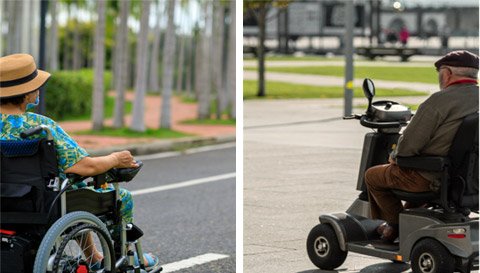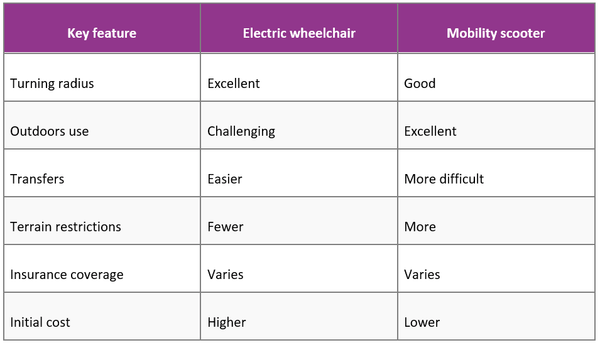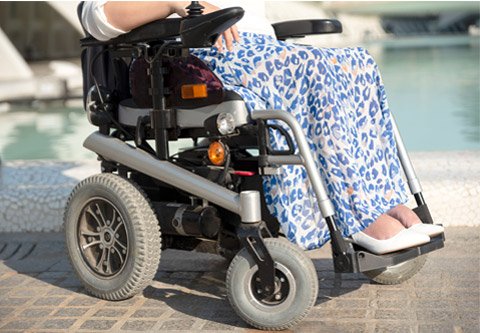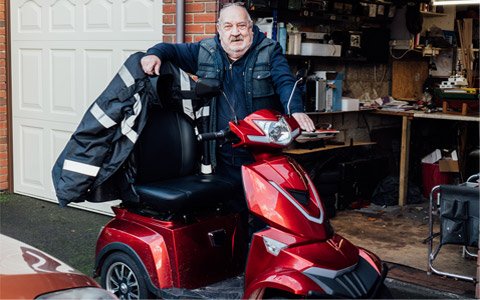Mobility devices like electric wheelchairs and mobility scooters are go-to tools that can help people with disabilities or limited mobility maintain their independence. Thanks to modern technology, you can buy an electric mobility device equipped with lots of handy features, including adjustable parts, a foot rest, an elevating seat, and much more.
The key when choosing one lies in understanding the main differences between powered chairs and mobility scooters. You should understand how to evaluate your specific needs and priorities when it comes to such an important decision in your life.
This article outlines the main features to look for when choosing an electric medical aid.
Jump to:
- Key differences between electric wheelchairs and mobility scooters
- Major types of mobility scooters and electric wheelchairs
- Factors to consider when choosing between electric wheelchair vs mobility scooter
- Additional tips to follow
- Pros and cons of both mobility devices
- Conclusion
Key differences between electric wheelchairs and mobility scooters
An electric wheelchair usually comes with a chair-like seat and a backrest. At the same time, a mobility scooter boasts a seat with a tiller for steering control. Powered wheelchairs tend to have a smaller turning radius, and such vehicles are more maneuverable than scooters. However, electric scooters for people with limited mobility excel at outdoor use with greater range and speed. Such devices have the ability to handle rough terrain with larger wheels and fat tires.

In terms of size and portability, electric wheelchairs are more customisable to user size. They can accommodate a variety of postures due to the device’s solid adjustability. You’re likely to find a power chair designed with accessories like leg rests, seat belts, and adjustable back/head rests. A foldable wheelchair model is travel-friendly, so you can easily transport them in a trunk while on the go.
Mobility scooters have less adjustability, but they can be disassembled into lightweight pieces for transport. Scooter manufacturers usually design their mobility devices so that they can be easily assembled/disassembled at home without an extra hand.
Comparison chart

Major types of mobility scooters and electric wheelchairs

Electric wheelchair types
There are three main configurations of electric chairs - rear-wheel drive, mid-wheel drive, and front-wheel drive models.
- Rear-wheel drive wheelchairs come with larger powered wheels at the back. This provides excellent traction and torque for climbing hills and handling rougher terrain outdoors.
- Mid-wheel drive models offer a tighter turning radius. They boast powered centre wheels below the user's centre of gravity, which is ideal for navigating tight indoor spaces.
- Front-wheel drives tend to be lighter, more portable and mimic the mobility experience of manual chairs, but lack stability descending inclines.
In addition to drive wheel configuration, powered wheelchairs range greatly in size, seat dimensions, turning radius, customisation accessories, and user weight capacities.
Smaller pediatric models can handle 100-150 pounds / 45 – 68 kilograms, while larger bariatric wheelchairs support over 500 pounds / 226 kilograms. Custom lightweight, rigid frame models provide superior maneuverability. Standard folding frame chairs offer better transportability at the expense of some ruggedness.

Mobility scooter types
For mobility scooters, key factors include overall size, degree of portability, seat comfort, handlebar adjustability, turning capabilities, and if a lift is needed for vehicle transport. The most portable travel scooters have a lightweight three-wheel design with quick disassembly, needing no tools that can fit trunks for easy transport. They typically handle shorter driving ranges under 15 miles per charge.
Full-size three and four-wheel designs often come with leverage, so you can split up the main components and fit the device more compactly into your car. However, such medical vehicles are heavier, and they require some strength and flexibility for loading/unloading. These three- and four-wheelers can better handle inclines and longer 20+ mile distances.
Larger mobility scooters with heavy, semi-portable pieces tend to stay stationary. They provide pillowed comfort for plus sizes as well as wider turns. These remain popular for older adults needing stability, especially mounting/dismounting the mobility scooter. Lift-enabled scooters are the largest models. They easily fit in full-sized vans and SUVs with the help of a handicap ramp. While the heaviest, such a mobility device provides safe and fully independent community mobility at extended ranges.
Factors to consider when choosing between electric wheelchair vs mobility scooter
Determining if an electric wheelchair or mobility scooter better fits your lifestyle depends largely on four key factors – budget, physical abilities, typical usage environments, and need for assistance.
Budget is often the first consideration. Electric wheelchairs range from £1,500 to £11,000+, while mobility scooters cost anywhere from £700 to £4,000+. Think of how often you’re going to use the device - on a daily basis or occasionally. In the case of daily use, the best option would be a solid chair from a reputable brand made of sturdy materials. For occasional use, you can alternatively consider a used wheelchair/scooter or renting one. Also, research insurance coverage, which varies greatly.
Assess physical abilities like flexibility, strength, coordination, and posture control. Can you operate a tiller? Do you require significant postural support? Such factors help determine if an electric wheelchair or scooter aligns better. Those lacking torso stability often find electric wheelchairs more supportive and customisable. In the case of fine motoric skills, a mobility scooter operated by a joystick is a nice option.
Also, consider the environment the device will be used in – at home, outdoors, or needing to be lifted into vehicles. A wheelchair excels at indoor mobility with better accessibility and turning capabilities, while a mobility scooter favors outdoor independent use, traveling faster (5-15 mph) and handling uneven terrain.
Another important option to consider is caregiver assistance. Electric wheelchairs facilitate assistance better during transfers or repositioning needs. Scooters allow more user independence. Identify how often and what type of help is needed.

Additional tips to follow
Test drive a mobility device you’re interested in to clarify your preferences. Find qualified vendors that allow test drives and have different models in a row. Try different models before you make the final decision, so you have options to choose from. Renting first also helps determine if a mobility vehicle fits your lifestyle before committing to purchasing.
When exploring electric wheelchair and scooter options, always ask about insurance coverage, third-party financing options, and included warranties. Reputable vendors will provide transparent estimates.
If you are concerned about your safety when you are out-and-about in your wheelchair or mobility scooter, consider an elderly GPS alarm or GPS personal alarm.
These devices allow you to call for help at the touch of a button from a specialist Emergency Resolution Team if you are distressed or need help. They even include GPS technology so the Emergency Resolution Team will know exactly where you are when you call.
Pros and cons of both mobility devices
Mobility scooters offer affordable independence for active users able to operate a tiller and transport the modular components. Limitations include rougher rides, weaker indoor navigability, fewer customisations, and a lack of posture support options compared to electric wheelchairs.
Alternatively, electric wheelchairs better serve those requiring significant postural or pain relief support. Models accommodating limited dexterity, strength, and coordination exist, including hands-free drive. Downsides involve much higher costs and strong reliance on caregivers for operation and transport.
Conclusion
Choosing between an electric wheelchair and a mobility scooter requires an honest evaluation of multiple factors, from physical abilities to typical usage. Outline these considerations against key feature comparisons between both mobility device options. Seek input from both medical providers and experienced vendors. Prioritise criteria most vital to maintaining independence and maximising funding support options. With proper research, the battle between mobility scooter vs electric wheelchair will be resolved stress-free. An electric wheelchair or mobility scooter can transform an older person's quality of life and, along with independent living aids for seniors, can maintain their independence.


